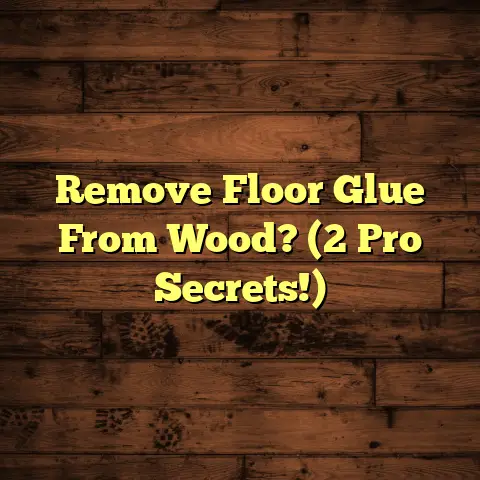Repair Termite Damaged Wood? (3 Fixes Save $$$)
Termites. Just the word can send shivers down a homeowner’s spine. I’ve seen firsthand the devastation these tiny creatures can wreak on wood structures. From the smallest homes to the largest commercial buildings, termite damage is a pervasive problem.
And let me tell you, ignoring it won’t make it go away. In fact, the longer you wait, the worse it gets. Termite damage can lead to serious structural issues, not to mention a significant hit to your wallet.
But don’t despair! The good news is that you don’t always need to call in a professional (and pay those hefty fees) right away. There are several DIY methods you can use to repair termite-damaged wood, saving you a ton of money.
In this article, I’m going to walk you through three primary repair methods that are not only effective but also designed with the DIY enthusiast in mind. My goal is to make these techniques accessible and easy to understand, so you can tackle termite damage head-on and protect your investment.
We’ll be covering:
- Patching with Epoxy: A versatile and durable solution for filling in damaged areas.
- Replacing Damaged Wood Sections: When the damage is too extensive for patching, replacement is key.
- Using Wood Hardener and Filler: A cost-effective way to reinforce weakened wood and restore its appearance.
So, are you ready to learn how to save some serious cash and reclaim your wood from those pesky termites? Let’s dive in!
Section 1: Method 1 – Patching with Epoxy
Overview of Epoxy as a Repair Material
What exactly is epoxy, and why is it such a great choice for repairing termite-damaged wood?
Well, epoxy is a thermosetting polymer that, when mixed with a hardener, creates a strong, durable, and chemical-resistant material. Think of it as a super-powered glue that can fill gaps, bond surfaces, and restore structural integrity. I find it a great option for smaller and confined repairs.
Here’s why I often recommend epoxy for termite damage repair:
- Strength: Epoxy is incredibly strong, even stronger than many types of wood. This makes it ideal for reinforcing weakened areas.
- Durability: It’s resistant to moisture, chemicals, and impact, ensuring your repairs last for years to come.
- Adhesion: Epoxy bonds exceptionally well to wood, creating a seamless and long-lasting repair.
- Versatility: You can sand, paint, and stain epoxy to match the surrounding wood, creating a virtually invisible repair.
In my experience, the key to a successful epoxy repair is choosing the right type of epoxy for the job. For wood repair, I typically recommend a two-part epoxy specifically formulated for wood. These epoxies are designed to penetrate the wood fibers, providing maximum strength and adhesion.
Step-by-Step Installation Process
Alright, let’s get down to the nitty-gritty. Here’s a step-by-step guide on how to patch termite-damaged wood using epoxy:
Preparation
-
Assess the Damage: First things first, you need to figure out the extent of the termite damage. Use a screwdriver or awl to probe the wood. If it feels soft or crumbles easily, it’s likely damaged. Mark the areas that need repair with a pencil.
-
Safety First: Termite-damaged wood can be brittle and may contain harmful chemicals. Wear gloves, a dust mask, and eye protection to protect yourself.
- Gloves: Protect your hands from splinters and chemicals.
- Dust Mask: Prevents you from inhaling wood dust and termite droppings.
- Eye Protection: Keeps debris out of your eyes.
-
Gather Your Supplies: Here’s what you’ll need:
- Two-part epoxy for wood repair.
- Mixing cups and sticks.
- Putty knife or applicator.
- Sanding block or sandpaper (various grits).
- Shop vacuum or brush.
- Wood chisel or scraper.
- Paint and primer (optional, for finishing).
Application
-
Clean the Damaged Area: This is crucial. Remove any loose wood, debris, and termite droppings from the damaged area. Use a wood chisel or scraper to carefully remove any softened wood. A shop vacuum can help you suck up all the loose particles.
-
Mix the Epoxy: Follow the manufacturer’s instructions carefully! Most two-part epoxies require you to mix equal parts of resin and hardener. Mix thoroughly for several minutes until you have a consistent, smooth mixture.
- Pro Tip: Use a timer to ensure you mix the epoxy for the recommended time. Under-mixing or over-mixing can affect its strength and curing time.
-
Apply the Epoxy: Using a putty knife or applicator, apply the epoxy to the damaged area. Press it firmly into any cracks and crevices. Overfill the area slightly, as the epoxy will shrink slightly as it cures.
-
Cure Time: Allow the epoxy to cure completely according to the manufacturer’s instructions. This can take anywhere from a few hours to 24 hours, depending on the product and the temperature.
Finishing Touches
-
Sand the Repaired Area: Once the epoxy is fully cured, use a sanding block or sandpaper to sand it down flush with the surrounding wood. Start with a coarse grit sandpaper (e.g., 80-grit) and gradually move to finer grits (e.g., 120-grit, 220-grit) to achieve a smooth finish.
-
Paint or Stain: If desired, paint or stain the repaired area to match the surrounding wood. Apply a primer first for better adhesion and a more uniform finish.
Cost Analysis
So, how much will this epoxy repair set you back? Let’s break it down:
- Two-Part Epoxy: $20-$50 (depending on the size and brand)
- Mixing Cups and Sticks: $5-$10
- Putty Knife or Applicator: $5-$15
- Sanding Block/Sandpaper: $5-$10
- Shop Vacuum (if needed): $50-$150 (if you don’t already own one)
- Wood Chisel or Scraper: $10-$30
- Paint and Primer (optional): $15-$30
Total Estimated Cost: $60-$245
Now, compare that to the cost of hiring a professional contractor. According to HomeAdvisor, the average cost of termite damage repair ranges from $550 to $3,000. So, by tackling the repair yourself with epoxy, you could potentially save hundreds or even thousands of dollars.
Section 2: Method 2 – Replacing Damaged Wood Sections
Overview of the Replacement Method
Sometimes, the termite damage is just too extensive for a simple epoxy patch. In these cases, replacing the affected wood sections is the best way to restore structural integrity and prevent further damage.
When is replacement the right choice?
- Extensive Damage: If the wood is severely weakened or crumbling, patching may not be sufficient.
- Structural Components: If the damage is to load-bearing beams, joists, or studs, replacement is essential for safety.
- Large Areas: If the damaged area is too large to effectively fill with epoxy, replacement is a more practical solution.
The advantages of replacing damaged wood sections include:
- Restored Structural Integrity: New wood provides a solid foundation and ensures the safety of your structure.
- Long-Term Solution: Replacement eliminates the damaged wood, preventing future termite infestations in that area.
- Improved Aesthetics: New wood can be easily painted or stained to match the surrounding area, improving the overall appearance.
Step-by-Step Installation Process
Alright, let’s get into the process of replacing damaged wood sections:
Assessment and Planning
-
Identify Damaged Sections: Carefully inspect the wood structure to identify all areas that need replacement. Use a screwdriver or awl to probe for soft or crumbling wood.
-
Measure and Cut: Measure the dimensions of the damaged wood sections. Use these measurements to cut new wood pieces to the exact size.
- Pro Tip: Use a miter saw for precise cuts and clean edges.
-
Choose the Right Wood: Select wood that is the same type and dimensions as the original wood. Pressure-treated lumber is a good choice for areas that are prone to moisture or termite infestation.
Removal of Damaged Wood
-
Gather Your Tools: You’ll need:
- Safety glasses
- Gloves
- Reciprocating saw or hand saw
- Hammer
- Chisel
- Pry bar
-
Cut Away Damaged Wood: Use a reciprocating saw or hand saw to carefully cut away the damaged wood sections. Cut along the marked lines, being careful not to damage any adjacent structures.
-
Remove Fasteners: Use a hammer and chisel or a pry bar to remove any nails, screws, or other fasteners that are holding the damaged wood in place.
-
Clean the Area: Remove any remaining debris and termite droppings from the area.
Installation of New Wood
-
Apply Wood Preservative: Before installing the new wood, apply a wood preservative to all surfaces to protect it from future termite infestations and decay.
-
Position the New Wood: Carefully position the new wood pieces in the area where the damaged wood was removed.
-
Secure the New Wood: Use nails, screws, or construction adhesive to securely fasten the new wood in place. Ensure that the fasteners are driven straight and flush with the surface of the wood.
-
Fill Gaps (if needed): If there are any gaps between the new wood and the surrounding structure, fill them with wood filler or caulk.
Cost Analysis
Let’s take a look at the costs associated with replacing damaged wood sections:
- New Wood: $10-$50 per piece (depending on size and type)
- Fasteners (nails, screws): $5-$10
- Wood Preservative: $10-$20
- Reciprocating Saw (if needed): $50-$150 (if you don’t already own one)
- Hammer and Chisel: $15-$30
- Pry Bar: $10-$20
- Wood Filler or Caulk: $5-$10
Total Estimated Cost: $105-$300+ (depending on the extent of the replacement)
While this method requires more materials than patching with epoxy, it can still save you a significant amount of money compared to hiring a professional contractor. Keep in mind that the cost of professional wood replacement can range from $500 to $5,000 or more, depending on the complexity of the job.
Section 3: Method 3 – Using Wood Hardener and Filler
Overview of Wood Hardener and Filler
For cases where the wood is weakened but not completely destroyed by termites, wood hardener and filler can be a fantastic solution. This method aims to reinforce the existing wood structure and restore its appearance without the need for extensive replacement.
What are wood hardener and filler?
- Wood Hardener: This is a liquid solution that penetrates into the softened wood fibers, solidifying them and making them more resistant to decay and further damage. It essentially strengthens the wood from within.
- Wood Filler: This is a paste-like substance used to fill in gaps, cracks, and voids in the wood. It can be sanded and painted to create a smooth, seamless finish.
The benefits of using wood hardener and filler include:
- Cost-Effectiveness: This is often the most affordable repair option, especially for smaller areas of damage.
- Ease of Use: The application process is relatively simple and requires minimal tools.
- Preservation of Original Wood: Instead of replacing the wood, this method helps preserve the original character and appearance of the structure.
Step-by-Step Installation Process
Here’s how to use wood hardener and filler to repair termite-damaged wood:
Preparation
-
Assess the Damage: As with the other methods, start by assessing the extent of the termite damage. Use a screwdriver or awl to probe the wood and identify softened areas.
-
Choose the Right Products: Select a wood hardener and filler that are specifically designed for wood repair. Make sure the hardener is compatible with the filler you choose.
-
Gather Your Supplies: You’ll need:
- Wood hardener
- Wood filler
- Paintbrush or applicator
- Putty knife or applicator
- Sanding block or sandpaper (various grits)
- Gloves
- Dust mask
Application of Wood Hardener
-
Clean the Area: Remove any loose wood, debris, and termite droppings from the damaged area. Use a brush or vacuum to clean the surface thoroughly.
-
Apply Wood Hardener: Apply the wood hardener liberally to the damaged area using a paintbrush or applicator. Allow the hardener to soak into the wood for the recommended time (usually several hours or overnight).
- Pro Tip: Apply multiple coats of wood hardener, allowing each coat to dry before applying the next. This will ensure maximum penetration and strengthening of the wood.
Filling the Damage
-
Mix the Wood Filler: Mix the wood filler according to the manufacturer’s instructions. Some fillers require you to add water or a hardener.
-
Apply Wood Filler: Using a putty knife or applicator, apply the wood filler to the damaged area. Press it firmly into any gaps and cracks, filling them completely. Overfill the area slightly, as the filler will shrink slightly as it dries.
-
Allow to Dry: Allow the wood filler to dry completely according to the manufacturer’s instructions. This can take anywhere from a few hours to 24 hours, depending on the product and the temperature.
Sanding and Finishing
-
Sand the Repaired Area: Once the wood filler is fully dry, use a sanding block or sandpaper to sand it down flush with the surrounding wood. Start with a coarse grit sandpaper (e.g., 80-grit) and gradually move to finer grits (e.g., 120-grit, 220-grit) to achieve a smooth finish.
-
Paint or Stain: If desired, paint or stain the repaired area to match the surrounding wood. Apply a primer first for better adhesion and a more uniform finish.
Cost Analysis
Let’s estimate the costs associated with using wood hardener and filler:
- Wood Hardener: $15-$30
- Wood Filler: $10-$20
- Paintbrush or Applicator: $5-$10
- Putty Knife or Applicator: $5-$15
- Sanding Block/Sandpaper: $5-$10
Total Estimated Cost: $40-$85
As you can see, this method is the most cost-effective of the three, making it an excellent choice for smaller repairs or for homeowners on a tight budget.
Conclusion
We’ve covered a lot of ground in this article, exploring three effective DIY methods for repairing termite-damaged wood:
- Patching with Epoxy: Ideal for smaller areas of damage where strength and durability are crucial.
- Replacing Damaged Wood Sections: The best choice for extensive damage or when structural integrity is compromised.
- Using Wood Hardener and Filler: A cost-effective solution for reinforcing weakened wood and restoring its appearance.
Each of these methods offers a way to save money compared to hiring a professional contractor. By taking the DIY route, you can tackle termite damage head-on and protect your investment without breaking the bank.
But remember, prevention is always better than cure. Regular inspections for termite damage are essential to catch problems early and prevent them from escalating. Here are some tips for preventing termite infestations:
- Keep Wood Dry: Termites thrive in moist environments. Ensure that your wood structures are properly ventilated and protected from water damage.
- Remove Wood Debris: Clear away any wood debris, such as firewood or fallen branches, from around your property.
- Seal Cracks and Gaps: Seal any cracks or gaps in your foundation and around pipes to prevent termites from entering your home.
- Consider Professional Inspections: Schedule regular termite inspections with a qualified pest control company to detect infestations early.
I urge you to take action against termite damage promptly. Don’t let those tiny creatures undermine the structural integrity of your home and drain your finances. With the methods outlined in this article, you can take control of the situation and protect your investment.
Now, I’d love to hear from you! Have you ever tackled termite damage repair yourself? What methods did you use, and what were your results? Share your experiences and questions in the comments section below. Let’s learn from each other and help our community of homeowners stay informed and empowered!





